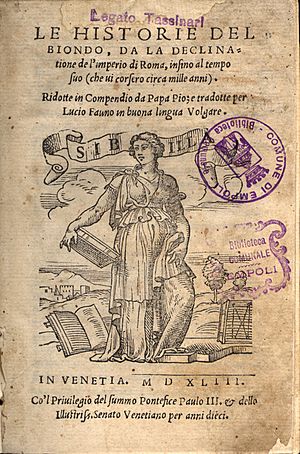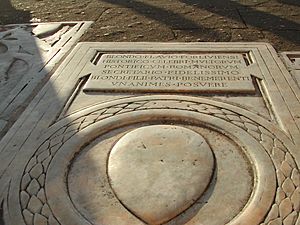Flavio Biondo facts for kids
Quick facts for kids
Flavio Biondo
|
|
|---|---|

Decades of History from the Deterioration of the Roman Empire, Italian translation by Lucio Fauno, 1543
|
|
| Born | 1392 Forlì, Romagna
|
| Died | June 4, 1463 (aged 70–71) |
| Scientific career | |
| Fields | Humanism and history |
| Patrons |
|
| Influences | Strabo |
Flavio Biondo (whose Latin name was Flavius Blondus) was an important Italian historian. He lived from 1392 to 1463. Flavio Biondo was one of the first people to divide history into three main parts: Ancient, Medieval, and Modern. He is also known as one of the very first archaeologists.
Flavio was born in Forlì, a city in the Romagna region of Italy. He went to school from a young age and studied with a teacher named Ballistario of Cremona. For a short time, he lived in Milan. There, he found and copied a special old book by Cicero called Brutus.
In 1433, Flavio moved to Rome and started his writing career. He became a secretary for Pope Eugene IV in 1444. He even traveled with the Pope when he had to leave Rome for a while. After Pope Eugene IV died, Flavio worked for other popes, including Pope Nicholas V, Pope Callixtus III, and Pope Pius II.
Contents
Exploring Ancient Rome: Archaeology
Flavio Biondo wrote three big books that were like detailed guides to the old ruins and places in ancient Rome. Because of these books, he is often called one of the first archaeologists. Later historians and people who studied old things used Flavio's work as a starting point.
At that time, the ruins of ancient Rome were covered in plants and not well explored. For example, in 1420, another scholar named Poggio Bracciolini climbed the Capitoline Hill. He saw only empty fields. The Roman Forum, a very important ancient area, was buried under dirt. Cows grazed there, and pigs dug in the weeds.
Flavio Biondo and other scholars, like Leon Battista Alberti, started to explore and write about Rome's buildings, places, and history. They helped people imagine how grand Rome used to be.
Rome Restored: De Roma instaurata
Flavio's first major work was De Roma instaurata, which means Rome Restored. This book was written between 1444 and 1448. It tried to show what ancient Rome looked like. This book was very important. It helped people dream of making Rome great again by understanding its past. It was the first detailed guide to the ruins of Rome, or any ancient ruins.
Rome Triumphant: De Roma triumphante
His second important book was De Roma triumphante, or Rome Triumphant, published in 1479. This book was about pagan Rome. It showed how ancient Roman ideas could be used to improve government and the army in his own time. The book helped bring back a sense of Roman pride. It also presented the papacy (the Pope's office) as a continuation of the Roman Empire.
Writing History: Major Works
Flavio Biondo's most famous works were Italia illustrata (Italy Illuminated) and Historiarum ab inclinatione Romanorum imperii decades (Decades of History from the Deterioration of the Roman Empire).
Italy Illuminated: Italia illustrata
The Italia illustrata was written between 1448 and 1458 and published in 1474. It was a geography and history book about fourteen regions of Italy. Flavio traveled a lot to gather information for this book. Unlike earlier mapmakers, Flavio thought of "Italy" as the whole peninsula, like the ancient geographer Strabo.
He wanted to connect ancient times with his own time through descriptions of places. He explained the origin of place names and how they changed. He also included important events linked to each location. This book started with the Roman Republic and Empire. It then covered 400 years of invasions and looked at important leaders like Charlemagne. It also gave a great description of how people in the 1400s became interested in ancient classic writings again.
History of the Roman Empire: Historiarum ab Inclinatione Romanorum Imperii
Flavio's biggest work is the Historiarum ab Inclinatione Romanorum Imperii. It was published in 1483. This book tells the history of Europe in 32 parts. It starts from the time Rome was attacked in 410 by the Visigoths. It continues up to Italy in 1442.
Flavio only used reliable and original sources for his history. He used the three-period framework for history, showing Italy getting better in his own time. Another historian, Leonardo Bruni, also used a similar three-period idea in his book about Florence around the same time.
See also
 In Spanish: Flavio Biondo para niños
In Spanish: Flavio Biondo para niños


